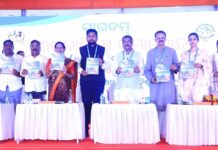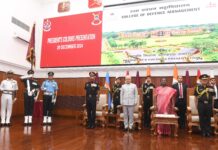By Press Information Bureau
ROORKEE:Third National Dam Safety Conference organized by Central Water Commission in association with Uttarakhand Jal Vidyut Nigam and IIT Roorkee concluded at Roorkee. The conference focused on key challenges in dam safety field that are being encountered in the on-going Dam Safety Rehabilitation and Improvement Project ( DRIP) implementation. Sharing of the knowledge, experience, innovations, novel technologies etc. by different national and overseas experts further helped in reshaping the strategies for effectively managing the uncertainties associated with dam design, construction, operation, and maintenance.
The conference received an overwhelming response with over 400 delegates attending and submission of over 70 technical papers from experts within and outside India. About 40 national and overseas organizations showcased their technologies, products and services through Exposition organized at the conference venue. The professionals from USA, Australia, Japan, UK, France, Italy, Spain, Netherlands, and Germany attended this event.
The Conference was inaugurated by Dr Amarjit Singh, Secretary, Ministry of Water Resources, River Development, Govt. of India in the presence of Sh S Ramaswamy, Chief Secretary, Government of Uttarakhand, Sh U P Singh, Director General, NMCG, MoWR, RD&GR, Prof. Ajit Kumar Chaturvedi, Director, IIT Roorkee, as well as other senior Central, State Government and DRIP implementing officials.
The interactions among the participants, with the organizations showcasing their technologies and products and with the experts presenting the papers will help dam safety professionals and managements in further determining the strategies for improved monitoring, operation and maintenance and rehabilitation of dams. The key recommendations emerging from the deliberations of the conference will be circulated to stakeholders as well as policy makers for implementation. Select technical papers received for the onference will be published as a Compendium to provide a permanent reference in the libraries of the State Agencies responsible for design, construction, operation and maintenance of dams.
Dams have played a key role in fostering rapid and sustained agricultural and rural growth and development, which have been key priorities for the Govt. of India since independence. Over the last seventy years, India has invested substantially in the critical infrastructure required to manage and store limited surface water resources in reservoirs to ensure food, energy, and water securities. Globally India ranks third after China and the United States of America in terms of number of large dams with a total storage capacity of about 283 billion cubic meters. Close to 80% of large dams have surpassed the age of twenty-five years, and many of them face the challenges of deferred maintenance. Many of these dams are considerably old (about 170 dams exceed the age of 100 years) and built in an era whose design practices and safety considerations do not match with the current design standards and the prevailing safety norms.
Several of these dams may be experiencing distress and are in urgent need of attention for ensuring their structural safety as well as operational efficiency.
Large dams’ failure may seriously affect the lives, property and the environment in addition to disrupting the services provided by the dam. Realizing the importance, Ministry of Water Resources, River Development and Ganga Rejuvenation embarked upon the six year Dam Safety Rehabilitation and Improvement Project (DRIP) with World Bank assistance in the year 2012 having provision of comprehensive rehabilitation and improvement of 225 large dam projects in seven States of India coupled with institutional reforms and strengthening of regulatory measures pertaining to safe and financially-sustainable dam operations. The project is being implemented in the seven States (Jharkhand, Karnataka, Kerala, Madhya Pradesh, Odisha, Tamil Nadu, and Uttarakhand).
The DRIP has been successful in bringing greater awareness on dam safety issues and addressing the serious problems by introducing novel solutions and technologies.
Since Project covers only 5% of large dams and seven States, to share knowledge and experience in dam safety areas with professionals of non-DRIP States, academician, industries as well as global experts, National Dam Safety Conferences (NDSC) are organized in different States as an annual event. These Conferences propagate the concepts, techniques, instruments, materials, etc. for design and construction of new dams, as well as for monitoring, surveillance, operation, maintenance and rehabilitation of existing dams.






























